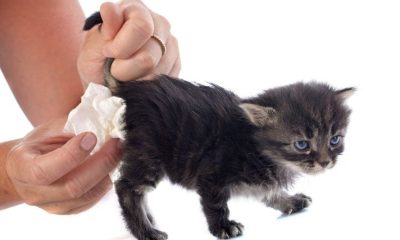Dogs
8 Clues To Determine What Your Dog Is Thinking

Are you curious about what your dog is thinking? If so, you’re not alone! Many pet owners are often curious about the inner thoughts and feelings of their canine companions. While we may never fully understand what our dogs are thinking, some helpful clues can give us an insight into their mind. In this blog post, we will explore 8 clues to determine what your dog is thinking. Through these clues, you’ll be able to better understand your pup’s thought processes and emotions. So, let’s dive in and learn more about dog thinking!
1) Ears
Pay close attention to your dog’s ears. A dog’s ears are a good indicator of its mood and what they’re thinking. If their ears are pricked up and facing forward, it means they’re alert and paying attention to something. If their ears are flat against their head, it’s a sign of fear or submission. If the ears are pulled back, it means they’re relaxed. Knowing how your dog’s ears move and react will help you determine what they’re thinking and feeling at any given moment.
2) Eyes
One of the most important tools for determining what your dog is thinking is its eyes. By looking at the shape, size, and focus of your dog’s eyes you can gain insight into its current mental state. For example, if your dog has wide-open eyes with their pupils dilated, this could indicate that they are feeling scared or excited. On the other hand, if they have narrowed eyes, they may be feeling relaxed or alert. Paying close attention to the way your dog’s eyes move around can also provide clues to its thought process – if your pup’s gaze is locked in on one particular object or person it may mean that it is thinking about engaging with them. If your dog is experiencing strong emotions, such as fear or aggression, their eyes may also appear to be bulging. Keeping an eye out for these cues can help you better understand what your dog is thinking.
3) Facial expressions
Facial expressions can be an important tool to help decipher what your dog is thinking. Pay attention to subtle changes in the mouth, such as a slight curl of the lips or wrinkling of the nose, as these can indicate various emotions. An open mouth with the tongue hanging out, for example, is often associated with contentment. On the other hand, if your dog’s eyes are wide and the eyebrows furrowed, it could be a sign of fear or aggression. It’s also important to look at the overall expression on your dog’s face. If their facial expression seems relaxed and serene, then they are likely feeling happy and secure. Dog thinking can often be read through these subtle changes in facial expressions, so be sure to pay close attention to your pup’s mug when you want to know what they’re thinking.
4) Body language
Your dog’s body language is one of the most obvious clues as to what they may be thinking. Pay attention to your pup’s stance, movements, and reactions when you approach or talk to them. Dogs who are feeling happy and comfortable will often wag their tail and keep their ears forward. Conversely, if your pup is feeling threatened or fearful, it may put its tail between its legs and cower down. Subtle changes in posture, such as a tense body, can also indicate that your dog is not comfortable with the current situation. By recognizing these behaviors, you can better understand what your pup is thinking and adjust the environment to help them feel more secure.
5) Vocalizations
One of the clearest ways to tell what your dog is thinking is by listening to their vocalizations. When a dog barks, whines, growls, or whimpers, it can be a sign that them trying to communicate something to you. Depending on the pitch and frequency of the sound, you may be able to get a better idea of what your dog is thinking.
A high-pitched bark may mean that your dog is happy or excited while a low-pitched growl may indicate fear or aggression. A whine or whimper can indicate confusion or insecurity and understanding these nuances will give you a better sense of what your dog is thinking. You may also be able to learn how to understand your dog’s barking and other vocalizations over time if you pay close attention to their behavior in certain situations.
In any case, vocalizations are an important clue to help you understand what your dog is thinking and feeling. Knowing what kind of vocalizations to listen for in different situations can help you identify potential problems and resolve them before they become serious issues.
6) Scent
Dogs rely heavily on their sense of smell to communicate with one another and to learn about their environment. Our dogs can detect subtle nuances in our scent that help them determine how we’re feeling and what we may be thinking. When it comes to dog thinking, the scent is a major component in how they perceive the world around them. Dogs use their sense of smell to tell if another dog is sick, happy, or angry. They can even tell when other dogs are feeling stressed or scared. We can also use scent to convey a message to our dogs. Certain scents, like lavender or chamomile, can create feelings of calmness and relaxation. Meanwhile, citrus smells can increase alertness and excitement. By using scents, we can help our dogs think positively and make them feel more comfortable.
7) Taste
Your dog’s taste buds are quite different from yours, but that doesn’t mean they aren’t just as sensitive. Watch your pup’s reaction to certain foods or treats to determine what he may be thinking. If he eagerly gobbles up the food, he’s likely feeling excited and happy. On the other hand, if he takes one look at it and turns his nose up, he’s likely feeling unenthused or disgusted. Try offering different types of food to figure out what your pup likes and dislikes. You can also use this as an opportunity to reward good behavior with a tasty treat!
8) Touch
Touch is an important part of understanding what your dog is thinking. Pay attention to the way your dog touches you, other dogs, and other people. For example, if your dog leans against you or nudges you with its nose, it could be a sign that it’s seeking attention or affection. Conversely, if your dog backs away when you reach out to pet them, it could be a sign that they’re feeling anxious or uncomfortable. Additionally, if your dog holds its tail between its legs or moves away from a person or situation, it could be a sign that they are feeling scared or intimidated. Paying close attention to the way your dog uses touch can provide valuable insight into their thoughts and feelings.
Read Also :
Dealing With Your Dog’s Weight Problems
Get Your Dog’s Nose Working: Tips for Developing Your Dog’s Sense of Smell
Dogs
Everything You Need to Know About Neutering for Pets

Lo
Neutering for pets is a common procedure that is important for the long-term health and well-being of your furry friend. Neutering involves surgically removing either the testes or the ovaries and uterus of an animal, usually a dog or cat. There are many benefits to neutering your pet, such as reducing their risk of cancer, controlling their behavior, and preventing unwanted litters. It is recommended that pet neutering be done at a young age, but it can be performed at any time. In this blog post, we will provide all the information you need to know about neutering for pets, including when it should be done and the potential risks involved.
Dogs
What to Do With Your Dog’s Body After Death: A Guide for Pet Owners

My dog died, and I’m not sure what to do with their body. It’s a heartbreaking moment for any pet owner, and the uncertainty of what to do can make it even more difficult. In this blog post, I’ll provide a comprehensive guide for pet owners on what to do with their dog’s body after death. We’ll cover everything from burial and cremation to taxidermy and memorializing your beloved pet. No matter what you decide to do, I hope this article will help you in this tough time and provide you with the resources you need to properly honor your pet’s life.
Dogs
Keep your distance: signs that you should keep away from your furry friend

When your pet displays certain symptoms, it is important to stay away to protect yourself and your pet. If you observe any of the following pet symptoms, it’s best to keep your distance until the issue has been addressed: lethargy, vomiting, diarrhea, excessive scratching or licking, shaking or trembling, sudden changes in appetite, coughing, sneezing, or discharge from the eyes or nose. Taking steps to stay away from your pet during these times will help to ensure the safety of both you and your furry friend.
Coughing and sneezing
Coughing and sneezing are common symptoms that our pets may experience from time to time. Just like us, they can catch colds or suffer from allergies, leading to these respiratory issues. While coughing and sneezing can be relatively harmless, it’s still important to take precautions to protect both you and your furry friend.
When your pet starts coughing or sneezing, keeping your distance is best. This is especially true if they have any other symptoms such as discharge from their nose or eyes, difficulty breathing, or lethargy. Coughing and sneezing can be signs of more serious underlying conditions such as respiratory infections or allergies. In some cases, they may even be contagious to humans, so it’s crucial to avoid close contact until you can consult a veterinarian.
Remember to provide a comfortable and clean environment for your pet to help alleviate their symptoms. Keep an eye out for any changes in their condition, and if their coughing or sneezing worsens or persists, make sure to seek professional help. Taking these precautions will help ensure the well-being of your pet and minimize any potential risks to yourself.
Trending

 Cats1 year ago
Cats1 year agoDon’t Feed Your Cat These 8 Foods!

 Cats11 months ago
Cats11 months agoWhy Do Cats Spray and How Can You Stop Them? Insights into Urine Spraying in Male Cats

 Cats10 months ago
Cats10 months agoThe Ins and Outs of Cat Sterilization: Removing the Female’s Ovaries

 Cats10 months ago
Cats10 months agoPre-Vaccination Prep: Getting Your Cat Ready

 Cats9 months ago
Cats9 months agoWhy Kittens are Born Dead or Deformed

 Dogs2 years ago
Dogs2 years agoSo You’re Thinking About Getting a Poodle

 Dogs10 months ago
Dogs10 months agoWhat to Do With Your Dog’s Body After Death: A Guide for Pet Owners

 Cats9 months ago
Cats9 months agoSigns of Cat Pregnancy Week by Week

















